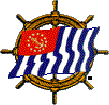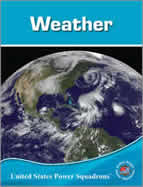Weather
This site is provided as a means of communications with the USPS National Marine Environment Committee (MEnvCom). We welcome your questions and comments on our courses, seminars and associated materials.
R/C Robert F. Anderson, AP
Stf/C Ronald H. Kessel, SN
Stf/C Judith Swanson, SN
Topics
|
|
|
|
|
|
|
|
News
New Basic Weather and Forecasting Seminar
An extensively revised edition of the committee's Basic Weather and Forecasting Seminar is now in inventory. The 2016 Edition comes with enhanced graphics and for the first time video and audio clips. The seminar continues a broad-based approach that covers basic weather dynamics and observation, but now adds modern sources of professional marine forecasts. The Instructor CD and Student Kit containing a hard copy of the Student Reference Guide can be ordered from National. (30 Jan 17)
New GRIDs and GRIBs: Computer Weather Forecasting and Navigation Webinar
In November 2016 the Committee introduced a new webinar that deals with the fascinating world of computer-generated forecasts, describes the different forecast products derived from them, how to get them anywhere in the world, and how to use them in conjunction with navigation charts. Like our other weather webinars, this one contains advanced subject matter. (30 Jan 17)
Errata for Weather 2012 Student Manual
Some errors have been noted in the Weather 2012 Student Manual. See the Downloadable Material section. (02 Dec 15)
NOAA designates USPS as a Weather-Ready Nation Ambassador
NOAA and its National Weather Service have recognized the major contribution that USPS makes in weather education for recreational boaters. The recognition took the form of USPS (and all its districts and squadrons) being designated a “Weather-Ready Nation Ambassador™.” The new designation is part of NOAA's Weather-Ready Nation initiative that emphasizes building situational awareness and community resiliency in facing increased vulnerability to extreme weather and water events.
All districts and squadrons are authorized and encouraged to use the new Weather-Ready Nation Ambassador logo. For more details about NOAA's initiative and the use of the logo go to: http://www.usps.org/national/eddept/wx/files/wrn.pdf The logo is also available separately at http://www.usps.org/national/eddept/wx/images/wrn-logo.png (04 Aug 15)
Online Seminar “Weather for Boaters” is available through BoatU.S. Foundation
We have adapted our excellent seminar "Basic Weather and Forecasting" to an online course format through the BoatU.S. Foundation. Now you can gain credit for having completed the seminar on your own computer at home. The course is available online by clicking here: http://www.usps.org/edonline/. Try it! (08 Sep 14)
Weather Course Description
The safety and comfort of those who venture out-on-the water have always been weather dependent. In this course students will become keener observers of the weather, but weather observations only have meaning in the context of the basic principles of meteorology — the science of the atmosphere.
The course focuses on how weather systems form, behave, move, and interact with one another and reflects the availability of all sorts of weather reports and forecasts on the Internet. Wx2012 is a general weather course benefiting those sitting in their living rooms, as much as those standing behind the helm. Each student receives:
-
a Weather Manual - USPS Weather - an explanatory text with full color photographs and drawings covering weather in the United States and its coastal and inland waters;
-
a set of three Daily Weather Maps - learning aids with a compete explanation of map symbols designed to develop weather map reading and analysis skills; and
-
NOAA’s Sky Watcher Chart - a reference to assist in identifying cloud types – helpful indicators of approaching weather.
The Weather Course is designed to be conducted over ten two-hour sessions including time for review and the multiple choice closed book exam, but each instructor will determine the pace of the course.
Weather Course Manual, etc.
The Weather course manual and other materials build on a long USPS tradition of presenting a comprehensive meteorologically (scientifically) oriented course designed for recreational boaters. The 2012 Revised Edition of the course manual has both text and graphic additions and enhancements, but its basic structure and contents remain the same as the Wx2008 course.
-
The Weather Course can be taught with a mix of the original Wx2008 and the revised edition Wx2012 Course Manuals.
-
The old paragraph numbers have been carried over to the revised edition, but many page references are different. New material in the Wx2012 manual is contained in additional paragraphs that are indicated by an “a” or a “b” following the paragraph that has been carried over.
-
The final closed-book examination remains the same.
Instructor Manual
This Instructor Manual is not the traditional black & white hard copy with all the thumbnail slide images. Instead it is a part of the instructor CD that contains the PowerPoint Presentation with slides and complete notes. Anecdotal evidence indicates that more and more instructors are not using the hard copy thumbnail images, but rather review the slides and notes using PowerPoint.
Three Appendices are a part of this manual. Two of them deal respectively with Upper-Air Charts and Sounding Analysis Diagrams. Instructors should read them. They are designed to provide instructors with additional background information to increase their comfort level in teaching various topics relating to atmospheric dynamics. The third relates to Clarifications and Corrections that pertain to the original Wx2008 Course Manual, but not to the revised edition Wx2012 one. It is provided in case some students are using the Wx2008 manual.
Instructor PowerPoint Presentation
In connection with the publication of the revised course manual, the PowerPoint presentation also has been updated with the addition of new slides and some minor changes in sequence. The revised presentation can be used with both the original and the revised course manuals.
There is an introductory set of five slides designed for use at the beginning of the first class. All the remaining slides are organized into the eight chapters of the manual. Within each chapter the slides are divided into two groups.
-
Wx08 /Wx12 Slide Group: The slides in the first group are designated “Wx08” or “Wx12” to indicate which slides have been added with the revised edition of the course manual. This group of integrated slides is a complete presentation of the material covered (and closely follows the organization of topics) in the chapter. The group includes figures in the manual as well as some supplemental slides. The slides begin each chapter with a title slide and a class activities/demonstrations slide—the latter being mainly for the benefit of the instructor. Most instructors will probably hide it. Each chapter presentation ends with a chapter summary.
-
Wx02 Slide Group: After the Wx08/Wx12 slides there is another group of slides that is designated Wx02. These “hidden” slides are legacy slides from the predecessor Wx2002 course that did not make the cut for this course. They are included only as an additional convenient resource for instructors. Unlike the Wx08/Wx12 slides, the slide notes have not been edited.
Final Exam
Except for some minor updating, the final examination is the same examination used with the Wx2008 Course Manual. In fact, going forward the same examination will be given to students regardless of which course manual they use. The new manual, however, contains a section of practice questions about weather scenarios. The new section comes after the Chapter 7 homework questions. Instructor’s should duplicate the Weather Scenarios section and give it to those students using the Wx2008 manual as a handout so they are not disadvantaged.
Examination Questions: The final examination is a typical 100-question USPS multiple-choice, closed-book test. About 80% of the exam questions will be based on homework questions. Unlike some of the homework questions, there will be no test questions that have the compound answers “all of the above”. The final examination will only include questions on the material in the first seven chapters. The material covered in Chapter 8 is reinforced through map drawing and analysis exercises.
Tips for the Examination: While the test will only cover the material in the first seven chapters, there is obviously some overlap in the topics dealt with in these chapters and Chapter 8 – Forecasting. If a topic is covered in one of the first seven chapters it may be on the exam even though it is also dealt with in Chapter 8. What follows are some points of clarification and some guidance for instructors and students.
Temperature Conversions: There will be no exam questions that require students to convert Fahrenheit degrees to Celsius degrees or vice versa (i.e., no questions like Chapter 1 homework questions 10 and 11 will be on the exam).
-
Station Models: Unlike exams for previous weather courses, station model questions will deal only with temperature, dew point, pressure, pressure tendency and wind speed and direction. There will be no questions about other symbols such as precipitation, cloud type or cloud cover. These additional station model elements are covered in Chapter 8 but only in connection with the use of the Daily Weather Maps.
-
Mid-Latitude Storm: Continuing a USPS weather course tradition, every exam will include verbatim the ten questions in the Chapter 6 homework based on a frontal mid-latitude storm figure (questions 20 – 29).
-
Scenarios: While there will be two of the customary “forecasting” scenarios on the exam (e.g., “Your cruiser is 50 miles east of….”), the analysis required to answer the three questions based on each scenario will not require any of the additional information contained in Chapter 8. Each scenario will be based upon one of the following weather events or patterns: warm front; cold front; thunderstorm squall line; advection fog; or waterspout.
A significant number of students are missing questions based on a scenario that involves a warm front pattern in the winter assuming that winter precipitation must involve a cold front. Some others are confusing an approaching warm front (indicated by a darkening sky with lowering layered–stratus-type clouds) and an approaching cold front or squall line (indicated by a line or wall of dark clouds and static or lightning).
Downloadable Material
Help Pages
See the Educational Department Help page to obtain any needed free viewers or shareware zip programs for these files. See the PowerPoint Help page for information on how to replace slides.
Errata for Weather 2012 Student Manual
Some errors have been noted in the Revised 2012 Edition of the USPS Weather Course Manual and the Instructor CD. There are a small number of substantive matters that should be clarified, refined or corrected. They have been identified with a bold asterisk [*] on an Update and Errata Sheet. The other errata on the sheet are typographical or formatting errors.
An errata sheet has not been furnished with the manual or the CD. Instructors should deal with the updates and errata as they see fit.
Get the Update and Errata Sheet (140KB, PDF) here. (02 Dec 15
Regional Weather
Appendix A of the Wx2008 Manual had a description of weather for selected regions of the United States. This Appendix is not in the Wx2012 Manual, but it can be downloaded as an additional resource (489KB, PDF). (30 Jan 12)
Weather Log
The following Weather Logs are for use in both the Cruising and Cruise Planning and Weather courses.
- Weather Log in Acrobat format (PDF, 13KB)
- Weather Log in MS Excel format (XLS, 26KB)
Frequently Asked Questions
There are no Frequently Asked Questions for Weather at this time.
Questions or Comments?
If you have any questions or comments about the Weather Course or any of the weather seminars or webinars, please contact the Chairman of the Marine Environment Committee. You can email the Chair by clicking on the Chair's name at the top of this page. Full contact information is given on the Committee Chairpersons page. Please be sure to keep your SEO and/or DEO advised of any correspondence you may have with the National committee.
We will try to answer your questions as soon as possible, but please allow 5 working days for an answer.
 |
|
|


